Traffic Light Priority for Trams in Warsaw as a Tool for Transport Policy and Reduction of Energy Consumption
Abstract
1. Introduction
1.1. Development of Tram Systems and Traffic Lights
1.2. Literature Review
- The topic of priority for trams in traffic lights is current and it appears in many scientific articles from the recent period;
- Many articles concern only selected aspects of the design of priority for trams, and few articles refer both to the analysis of the sequence and the effects of the implementation of the designed solutions;
- Very few articles deal with the environmental impact of the priority for trams;
- When designing a priority system for trams, it is necessary to consider many infrastructure factors as well as traffic factors such as timetables, passenger flows, and passenger interchange times.
1.3. Article Content
2. Methods
2.1. Design of Modern Tram Traffic Control Systems
- Data on the traffic of trams not included in the timetable (e.g., departures and departures from the depot);
- Data on tram stop service—the times of passenger exchange and their schedule, the time of door opening and closing, etc.;
- Data on passing times for sections between junctions, considering restrictions resulting from the infrastructure (curves, switches).
- Time conditions related to vehicle tracking on approach to an intersection;
- Time conditions specific to the selected sequence of stages when a priority request is registered (shortening of signals during conflicting stages);
- Logical variables for storing events (e.g., occupancy on a detector or occurrence of a stage or a stage transition) which influence further algorithm realization;
- Conditions related to blocking a transition to another stage in case of a demand for priority tram service.
2.2. Modeling in Vissim
- Variant 1—isolated, fixed-time control (programs and signaling plans functioning before the activation of the priority);
- Variant 2—fixed-time programs prepared as a basis for running the priority and coordination for cars;
- Variant 3—accommodating programs with priority for trams.
2.3. Calculating Emmisions and Energy Consumption
3. Results
3.1. Influence of Control Strategy on Traffic Conditions
3.2. Influence of Control Strategy on Pollutants Emission
3.3. Influence of Control Strategy on Energy Consumption
4. Discussion
5. Conclusions
Author Contributions
Funding
Data Availability Statement
Conflicts of Interest
References
- Bojanowski, A. Warszawskie Tramwaje Elektryczne 1908–1998; WKiŁ: Warsaw, Poland, 1998. [Google Scholar]
- Allsop, R.E.; Tracz, M. Skrzyżowania z Sygnalizacją Świetlną; WKiŁ: Warsaw, Poland, 1990. [Google Scholar]
- Instrukcja o Znakach i Sygnałach na Drogach–Zarządzenie Ministrów Komunikacji, Gospodarki Terenowej i Spraw Wewnętrznych z Dnia 16 Grudnia 1974. Available online: http://isap.sejm.gov.pl/isap.nsf/DocDetails.xsp?id=WMP19740420264 (accessed on 1 April 2021).
- Cegiałko, S.; Karsznia, I. A comparative analysis of urban development and the tram line network in Lviv in 1932–2016. Pol. Cartogr. Rev. 2020, 52, 74–84. [Google Scholar] [CrossRef]
- Domenech-Carbó, A. Rise and fall of historic tram networks: Logistic approximation and discontinuous events. Phys. A Stat. Mech. Appl. 2019, 522, 315–323. [Google Scholar] [CrossRef]
- Shi, J.; Sun, Y.; Schonfeld, P.; Qi, J. Joint optimization of tram timetables and signal timing adjustments at intersections. Transp. Res. Part C Emerg. Technol. 2017, 83, 104–119. [Google Scholar] [CrossRef]
- Zhang, T.; Mao, B.; Xu, Q.; Feng, J. Timetable Optimization for a Two-Way Tram Line with an Active Signal Priority Strategy. IEEE Access 2019, 7, 176896–176911. [Google Scholar] [CrossRef]
- Naznin, F.; Currie, G.; Logan, D. Exploring road design factors influencing tram road safety: Melbourne tram driver focus groups. Accid. Anal. Prev. 2017, 110, 52–61. [Google Scholar] [CrossRef] [PubMed]
- Rozporządzenie Ministra Infrastruktury z Dnia 3 Lipca 2003 r. w Sprawie Szczegółowych Warunków Technicznych Dla Znaków i Sygnałów Drogowych Oraz Urządzeń Bezpieczeństwa Ruchu Drogowego i Warunków ich Umieszczania na Drogach. Available online: http://isap.sejm.gov.pl/isap.nsf/DocDetails.xsp?id=wdu20032202181 (accessed on 1 April 2021).
- Pavkova, K.; Currie, G.; Delbosc, A.; Sarvi, M. Selecting tram links for priority treatments: The Lorenz Curve approach. J. Transp. Geogr. 2016, 55, 101–109. [Google Scholar] [CrossRef]
- Rychlewski, J.; Kaczmarek, M. Tram Priority Traffic Control on Complex Intersections. Control Transp. Syst. 2006, 39, 416–420. [Google Scholar] [CrossRef]
- Zhao, B.; Zhang, Y.; Zhang, Z.; Jin, M.; Li, Z. Study on Signal Priority Implement Technology of Tram System. Procedia Soc. Behav. Sci. 2013, 96, 905–913. [Google Scholar] [CrossRef][Green Version]
- Zhang, L.; Garoni, T. A Comparison of Tram Priority at Signalized Intersections. arXiv 2013, arXiv:1311.3590. [Google Scholar]
- Zhou, W.; Bai, Y.; Li, J.; Zhou, Y.; Li, T. Integrated Optimization of Tram Schedule and Signal Priority at Intersections to Minimize Person Delay. J. Adv. Transp. 2019, 1494, 1–18. [Google Scholar] [CrossRef]
- Yan, H.; Ou, D.; Chen, Z.; Yang, Y. Research on Tram Detector Location Based on Vehicle–Infrastructure Communication. In Proceedings of the 3rd International Conference on Electrical and Information Technologies for Rail Transportation (EITRT), Changsha, China, 20–22 October 2017; pp. 915–925. [Google Scholar]
- Sun, Z.; Dai, L.; He, G. Signal Priority Control Methods of Modern Trams at Intersections. ICTE 2015, 520–527. [Google Scholar]
- Budzyński, M.; Szmagliński, J.; Jamroz, K.; Birr, K.; Grulkowski, S.; Wachnicka, J. Assessing Tram Infrastructure Safety Using the Example of the City of Gdańsk. J. Konbin 2019, 49, 293–322. [Google Scholar] [CrossRef]
- Tubis, A.; Rydlewski, M.; Budzyński, M. Safety Assessment of Tram Stops. J. Konbin 2019, 49, 431–458. [Google Scholar] [CrossRef]
- Tubis, A.; Rydlewski, M.; Budzyński, M. The Indicators Assessment of Safety and Functionality of Tram Loops. J. Konbin 2020, 50, 21–41. [Google Scholar] [CrossRef]
- Zhou, H.; Zhang, C.; Zhan, J.; Zhang, J. Research on the city tram collision at a level crossing. Adv. Mech. Eng. 2018, 10, 1–12. [Google Scholar] [CrossRef]
- Budzyński, M.; Tubis, A.; Jamroz, K. Identifying Selected Tram Transport Risks. IOP Conf. Ser. Mater. Sci. Eng. 2019, 603, 042053:1–042053:10. [Google Scholar] [CrossRef]
- Szala, K.; Kubicka, A.; Sparks, T.; Tryjanowski, P. Birds using tram tracks in Poznań (Poland): Species, infrastructure use and behaviour. Transp. Res. Part D 2020, 81, 102282:1–102282:8. [Google Scholar] [CrossRef]
- Rendeková, A.; Micieta, K.; Randáková, Z.; Ballová, D.; Eliašová, M.; Miškovic, J. Flora of the tram tracks of Bratislava. Urban Ecosyst. 2020, 23, 875–891. [Google Scholar] [CrossRef]
- Sobota, A.; Żochowska, R.; Szczepański, E.; Gołda, P. The influence of tram tracks on car vehicle speed and noise emission at four-approach intersections located on multilane arteries in cities. J. Vibroeng. 2018, 20, 2453–2468. [Google Scholar] [CrossRef]
- Xiao, Z.; Sun, P.; Wang, Q.; Zhu, Y.; Feng, X. Integrated Optimization of Speed Profiles and Power Split for a Tram with Hybrid Energy Storage Systems on a Signalized Route. Energies 2018, 11, 478. [Google Scholar] [CrossRef]
- Czerepicki, A.; Górka, A.; Szustek, J. Analysis of Trams’ Consumption Depending on the Type of Traffic Light Used. Sci. Tech. 2019, 18, 490–494. [Google Scholar] [CrossRef]
- Jeong, Y.; Kim, Y. Tram passive signal priority strategy based on the MAXBAND model. KSCE J. Civ. Eng. 2014, 18, 1518–1527. [Google Scholar] [CrossRef]
- Šojat, D.; Brčić, D.; Slavulj, M. Analysis of transit service improvements in the city of Zagreb. Teh. Vjesn. 2017, 24, 217–223. [Google Scholar] [CrossRef]
- Chen, C. Tram development and urban transport integration in Chinese cities: A case study of Suzhou. Econ. Transp. 2018, 15, 16–31. [Google Scholar] [CrossRef]
- Potemkina, M.; Makarova, N.; Pashkovskaya, T.; Chernova, N.; Popov, M. Tram service as a factor of everyday life in the Soviet city of Magnitogorsk. J. Appl. Eng. Sci. 2020, 18, 485–492. [Google Scholar] [CrossRef]
- Wontorski, P. The concept of an integrated rail transit system based on tram-trains in the metropolitan area on the example of Piaseczno. Transp. Overv. Przeglad Komun. 2020, 5, 20–35. [Google Scholar] [CrossRef]
- Higgins, D.; Rezaei, A.; Wood, P. The value of a tram station on local house prices: An hedonicmodelling approach. Pac. Rim Prop. Res. J. 2019, 25, 217–227. [Google Scholar] [CrossRef]
- Fang, Y.; Jiang, Y.; Fei, W. Disruption Recovery for Urban Public Tram System: An Analysis of Replacement Service Selection. IEEE Access 2020, 8, 31633–31646. [Google Scholar] [CrossRef]
- Vujičić, M.; Prester, J. Assessing service quality of public tram transport in Zagreb city using P-TRANSQUAL mode. Zb. Èkon. Fak. Zagreb. 2019, 17, 19–31. [Google Scholar] [CrossRef]
- Nishiuchi, H.; Kobayashi, Y.; Todoroki, T.; Kawasaki, T. Impact analysis of reductions in tram services in rural areas in Japan using smart card data. Public Transp. 2018, 10, 291–309. [Google Scholar] [CrossRef]
- Langhe, K.; Meersman, H.; Sys, C.; Van de Voorde, E.; Vanelslander, T. How to make urban freight transport by tram successful? J. Shipp. Trade 2019, 13, 1–23. [Google Scholar] [CrossRef]
- Yang, M.; Ding, J.; Wang, W.; Ma, Y.-Y. A coordinated signal priority strategy for modern trams on arterial streets by predicting the tram dwell time. KSCE J. Civ. Eng. 2017, 22, 1–14. [Google Scholar] [CrossRef]
- Śmigielski, H. Sygnalizacja Teletechniczna; Wydawnictwo Komunikacyjne: Warsaw, Poland, 1953. [Google Scholar]
- Krukowicz, T. Method of Designing Traffic Actuated Control Algorithms for Uncoordinated Intersection. Ph.D. Thesis, Warsaw University of Technology, Warsaw, Poland, 2018. [Google Scholar]
- Krukowicz, T.; Kusiakowski, K. Projekt Budowlany Wykonania Dokumentacji Remontu i Rozbudowy Trasy Tramwajowej w Ciągu Ulic Targowej, Zamoyskiego, al. Zieleniecka od Węzła Dw. Wileński do Węzła Rondo Waszyngtona, Projekt stałej Organizacji Ruchu–Projekt Ruchowy Sygnalizacji Świetlnych–ETAP 1; CTD S.C.: Warsaw, Poland, 2011. [Google Scholar]
- Bąk, R.; Chodur, J. Wpływ strategii sterowania przy braku zgłoszeń na funkcjonowanie skrzyżowań z sygnalizacją poza terenem zabudowy. Logistyka 2012, 3, 431–440. [Google Scholar]
- Szustek, J.; Górka, A. Wirtualna detekcja tramwajowa. In Proceedings of the Sygnalizacja Świetlna 2019, Kraków, Poland, 17–18 October 2019. [Google Scholar]
- Szustek, J. Modelowanie mikroskopowe w kontekście testowania algorytmów z priorytetem dla tramwajów. TMIR 2016, 7, 24–28. [Google Scholar]
- PTV AG. PTV VISSIM 8 User Manual; PTV AG: Karlsruhe, Germany, 2015. [Google Scholar]
- Husch, D.; Albeck, J. Synchro Studio 7 User Guide; Trafficware: Sugar Land, TX, USA, 2006. [Google Scholar]
- Gartner, N.H.; Messer, C.J.; Rathy, A.K. Revised Monograph on Traffic Flow Theory; Federal Highway Administration: Washington, DC, USA, 1992.
- Kozłowski, M. Analysis of dynamics of a scaled PRT (personal rapid transit) vehicle. J. Vibroeng. 2019, 21, 1426–1440. [Google Scholar] [CrossRef]
- Kozłowski, M. Simulation method for determining traction power of ATN–PRT vehicle. Transport 2016, 33, 335–343. [Google Scholar] [CrossRef]
- Czerepicki, A. Study on effectiveness of using column-oriented databases in the processing of measurement characteristics of an electric vehicle. Arch. Transp. 2019, 51, 77–84. [Google Scholar] [CrossRef]
- Li, Y.; Cai, Q.; Xu, Y.; Shi, W.; Chen, Y. Design of real-time actuated control system for modern tram at arterial intersections based on logic rules. Adv. Mech. Eng. 2018, 10, 1–13. [Google Scholar] [CrossRef]
- Ji, Y.; Tang, Y.; Shen, Y.; Du, Y.; Wang, W. An Integrated Approach for Tram Prioritization in Signalized Corridors. IEEE Trans. Intell. Transp. Syst. 2020, 21, 2386–2395. [Google Scholar] [CrossRef]
- Ji, Y.; Tang, Y.; Wang, W.; Du, Y. Tram-Oriented Traffic Signal Timing Resynchronization. J. Adv. Transp. 2018, 8796250:1–8796250:14. [Google Scholar] [CrossRef]
- Bogdan, S.; Grebenisan, G.; Ulica, D.; Ratiu, M. The implementation of an adaptive traffic light concept in regards to tram access in a complex intersection. IOP Conf. Ser. Mater. Sci. Eng. 2019, 568, 012097:1–012097:5. [Google Scholar] [CrossRef]
- Naznin, F.; Currie, G.; Sarvi, M.; Logan, D. An empirical bayes safety evaluation of tram/streetcar signal and lane priority measures in Melbourne. Traffic Inj. Prev. 2015, 17. [Google Scholar] [CrossRef] [PubMed]
- Kulesz, B.; Sikora, A. Comparison of different tram cars in Poland basing on drive tram systems. MATEC Web Conf. 2018, 180, 02006:1–02006:6. [Google Scholar] [CrossRef]
- Guo, C.; Zhang, A.; Zhang, H. Model Predictive Control for Tram Charging and Its Semi-Physical Experimental Platform Design. J. Power Electron. 2018, 18, 1771–1779. [Google Scholar] [CrossRef]
- Ko, Y.; Jang, Y. Efficient design of an operation profile for wireless charging electric type, rated power and energy consumption. MATEC Web Conf. 2018, 180, 02006. [Google Scholar] [CrossRef]
- Liu, J.; Wu, X.; Li, H.; Qi, L. An optimal method of the energy consumption for fuel cell hybrid tram. Int. J. Hydrog. Energy 2020, 45, 20304–20311. [Google Scholar] [CrossRef]
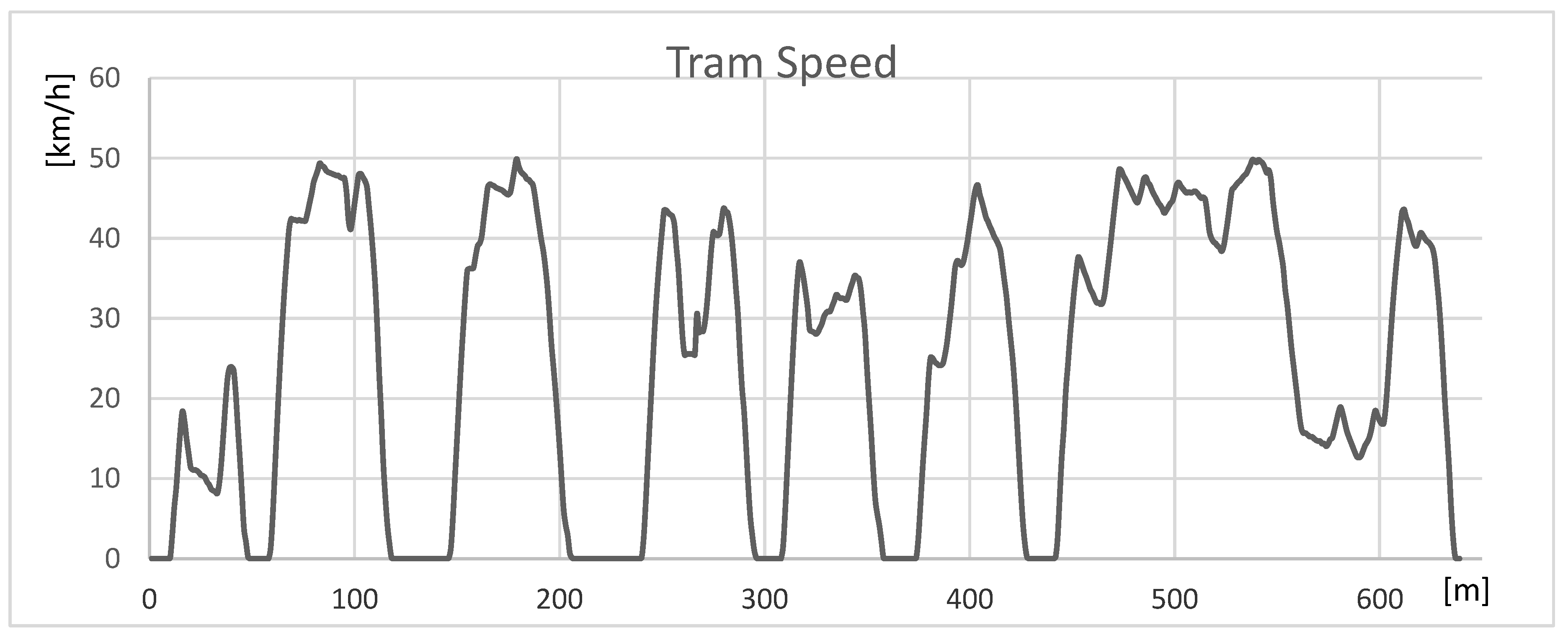
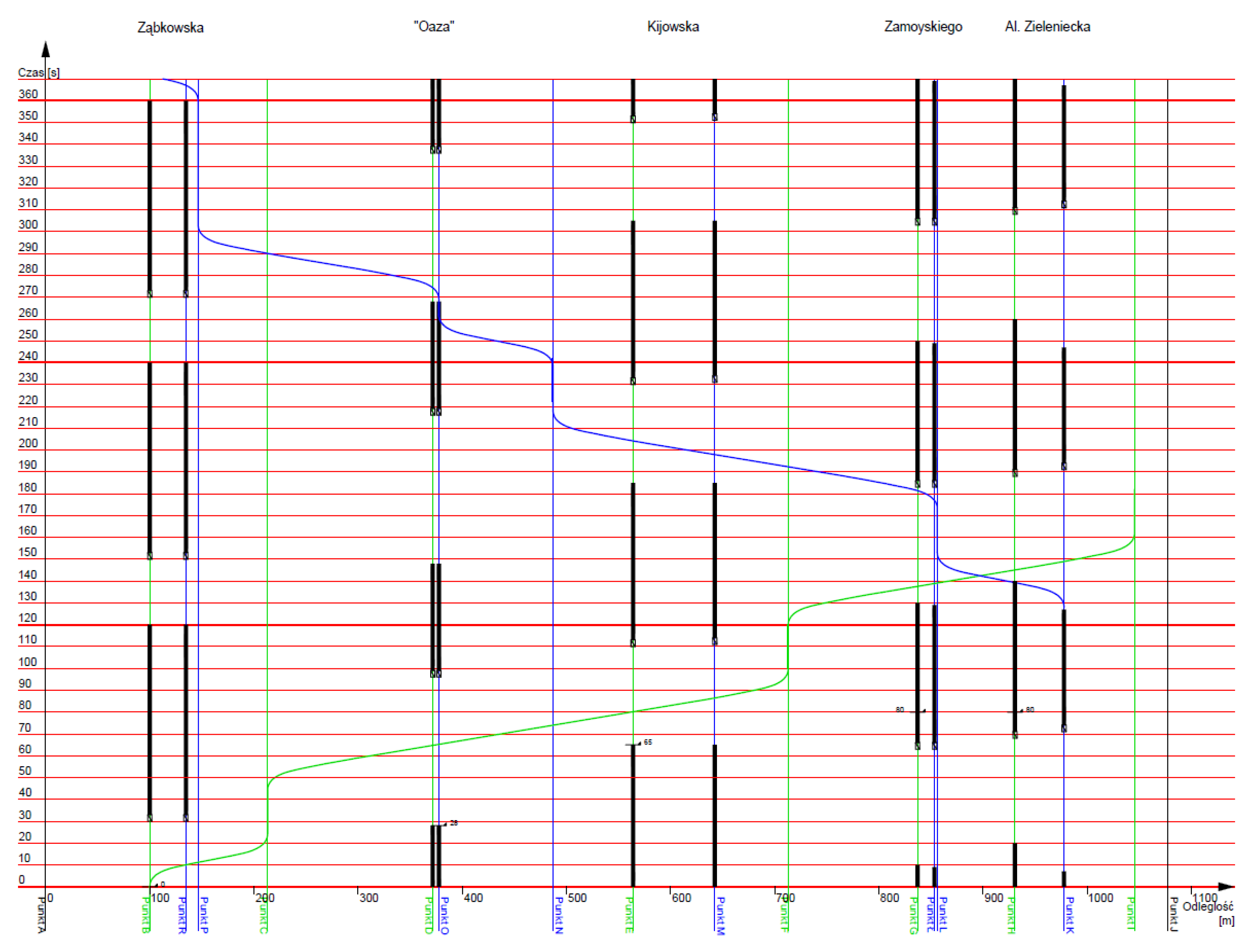
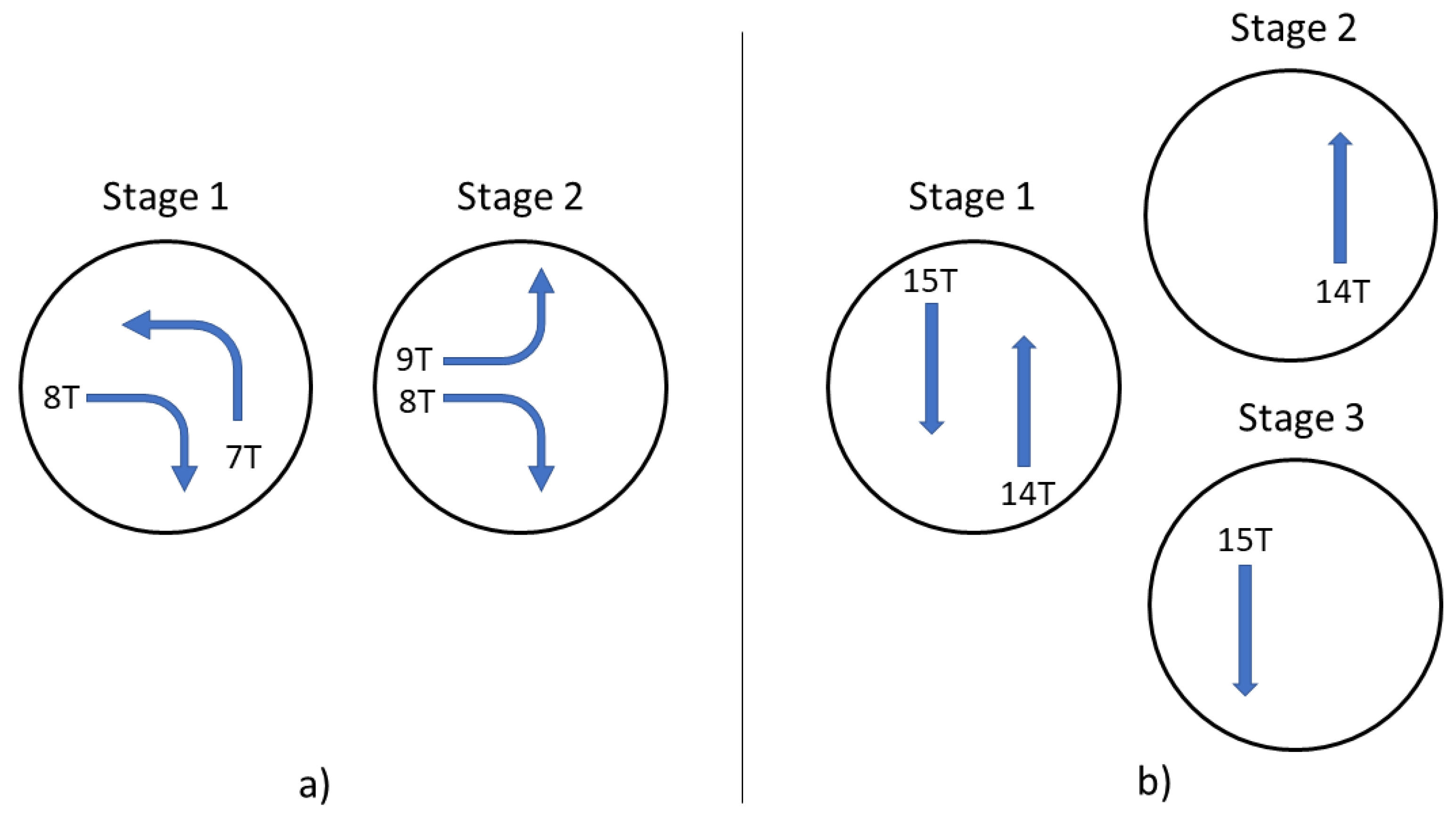
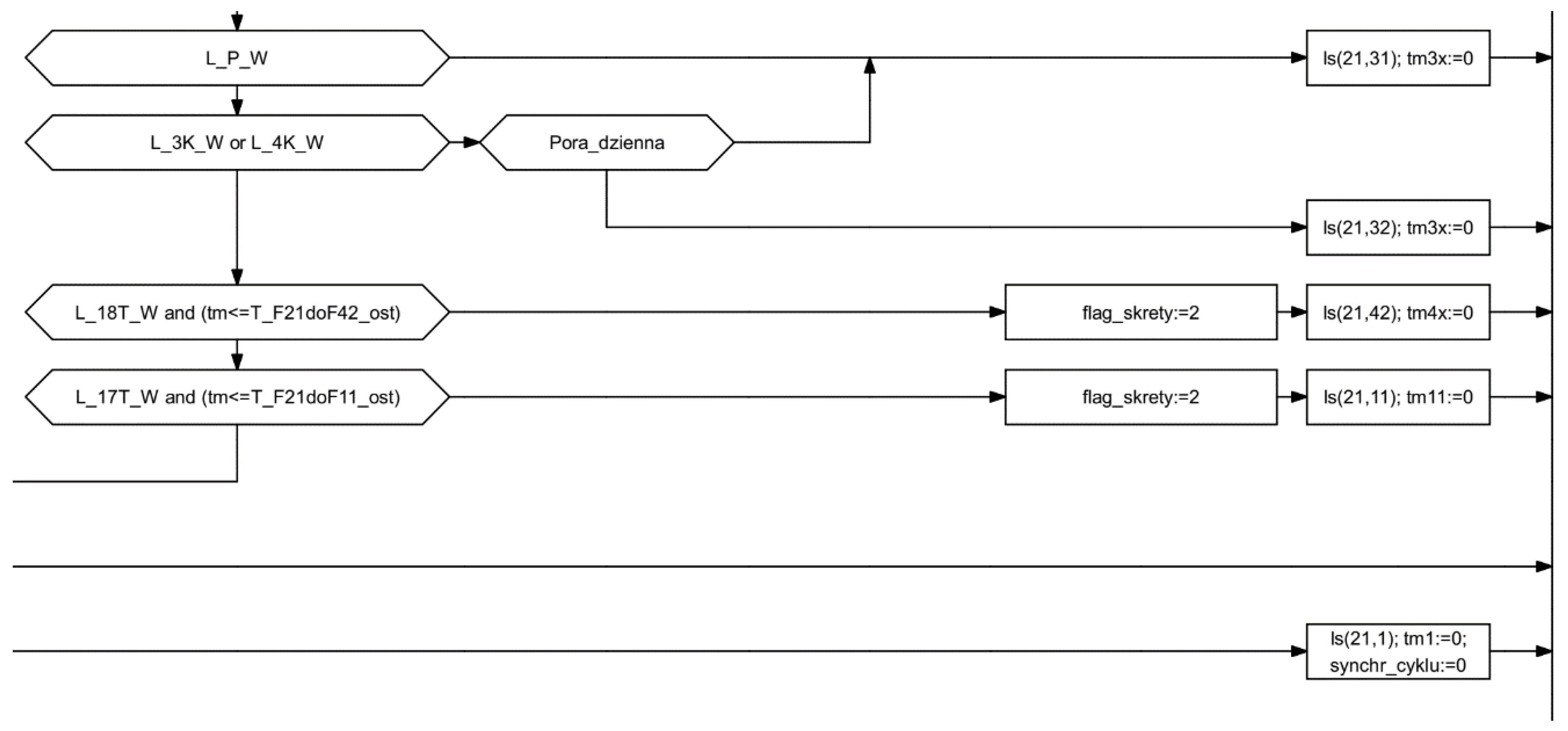

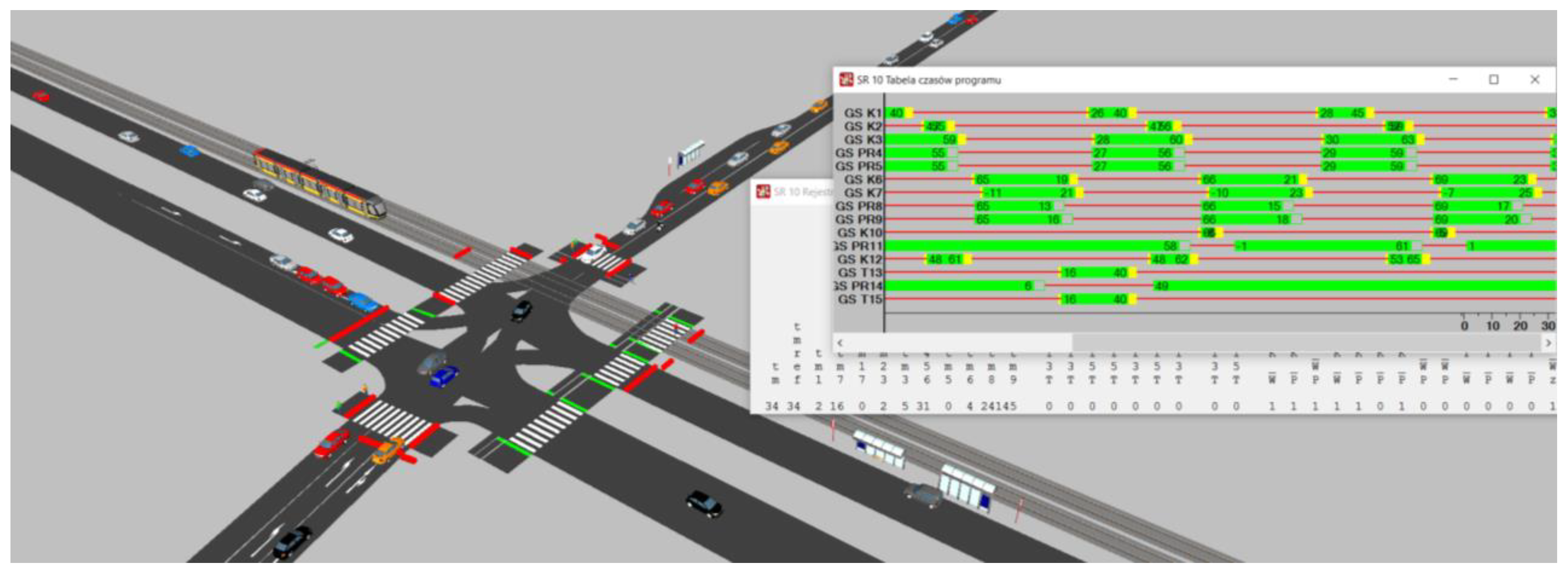

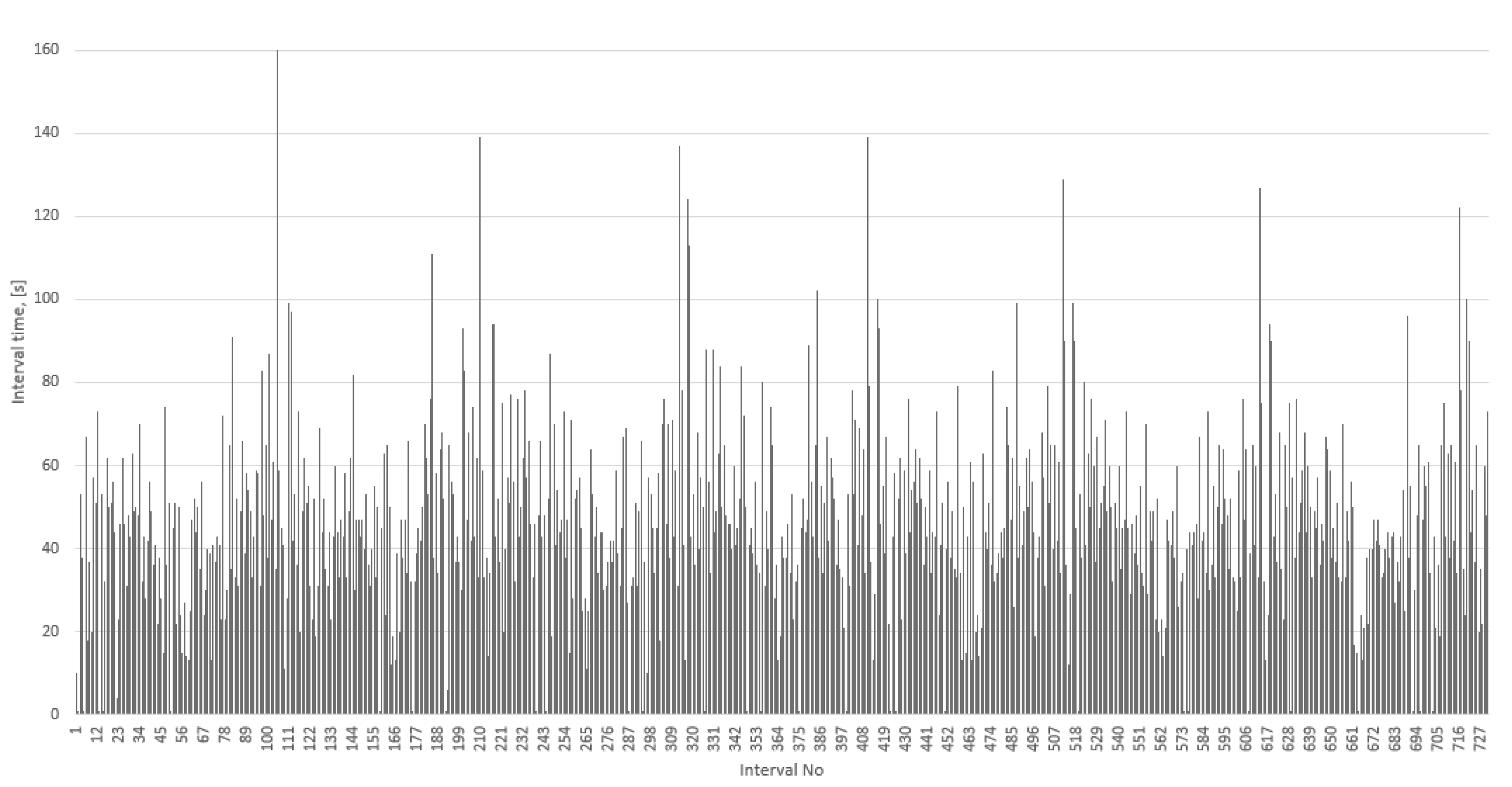
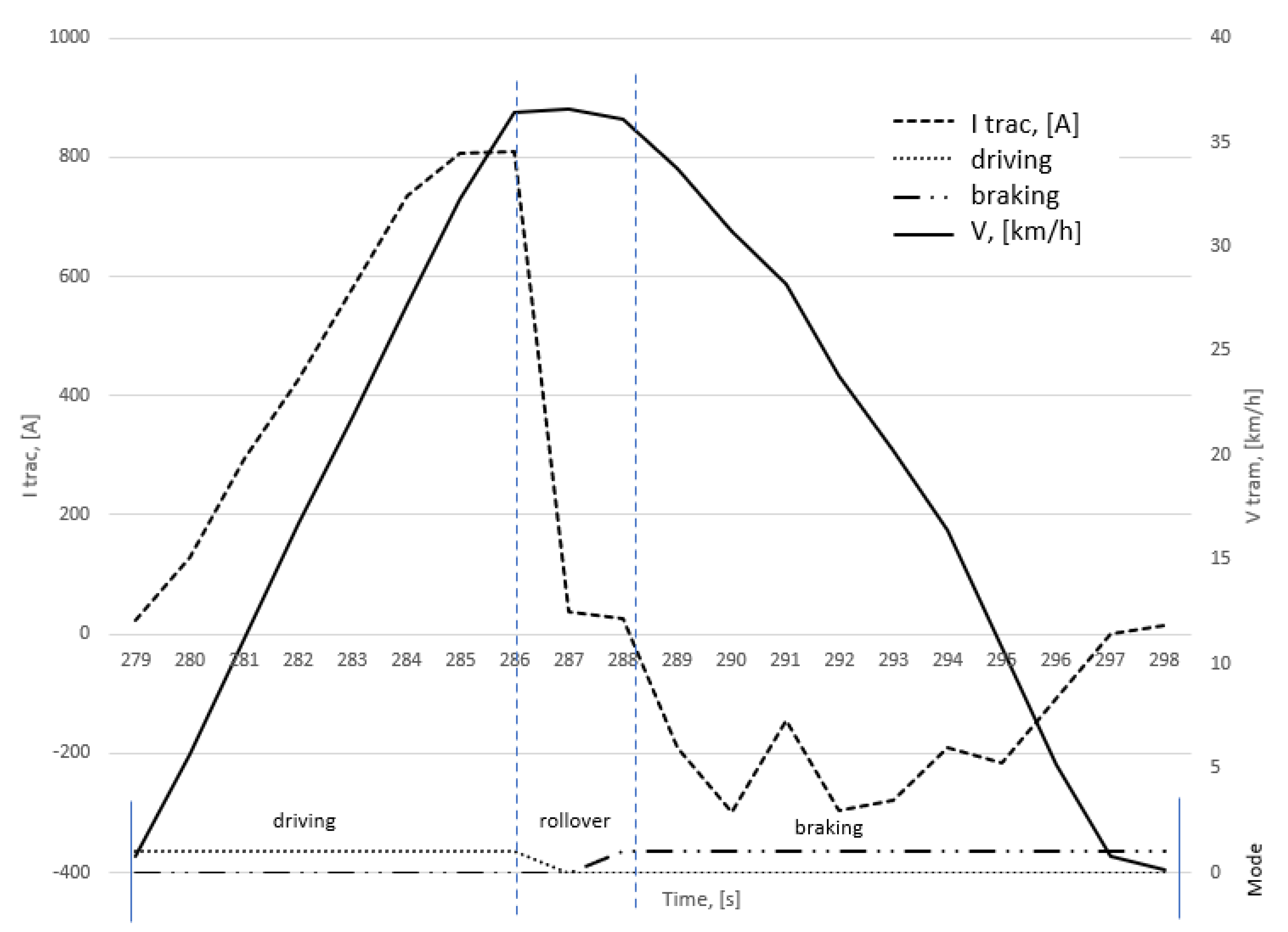
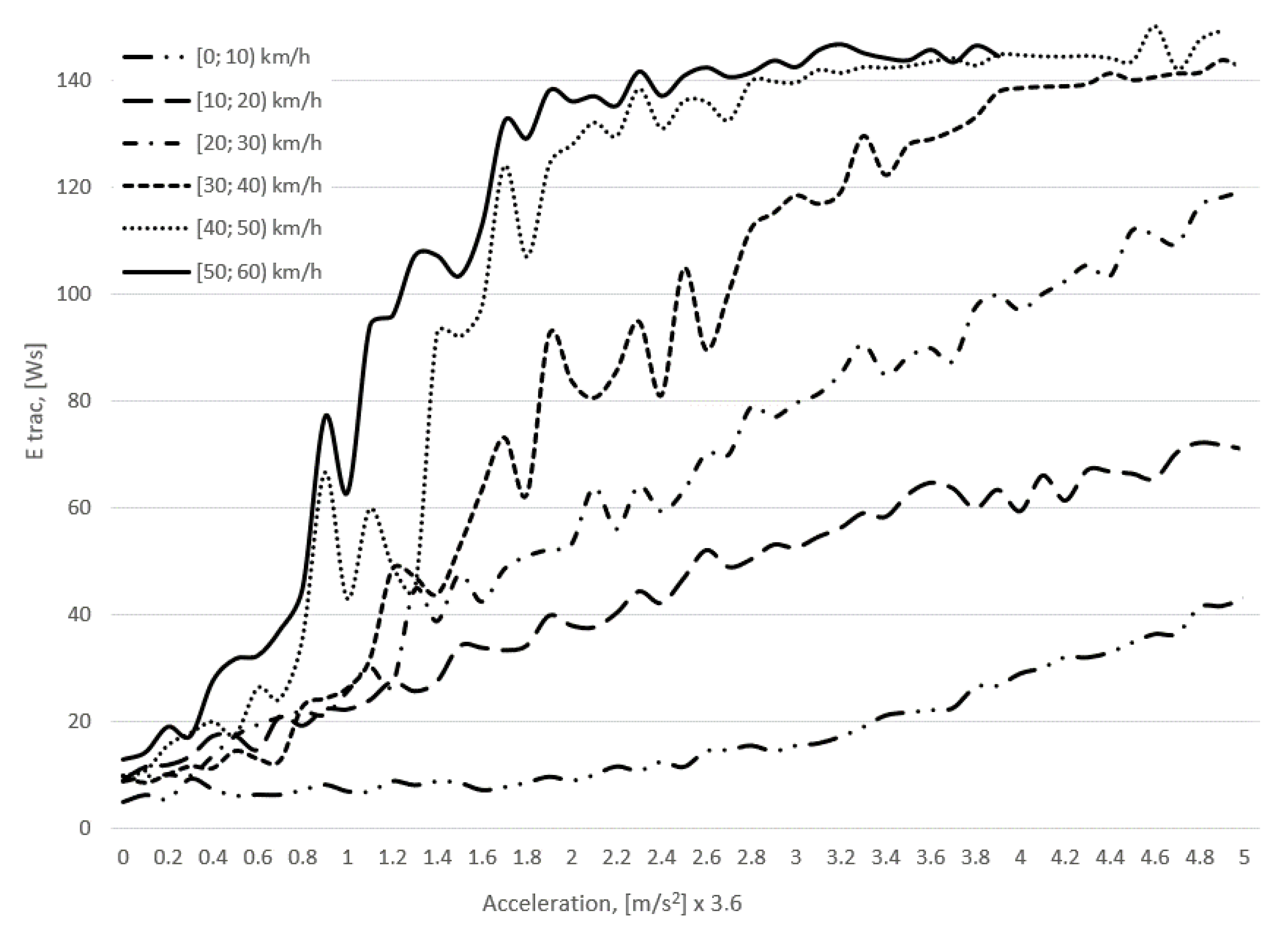

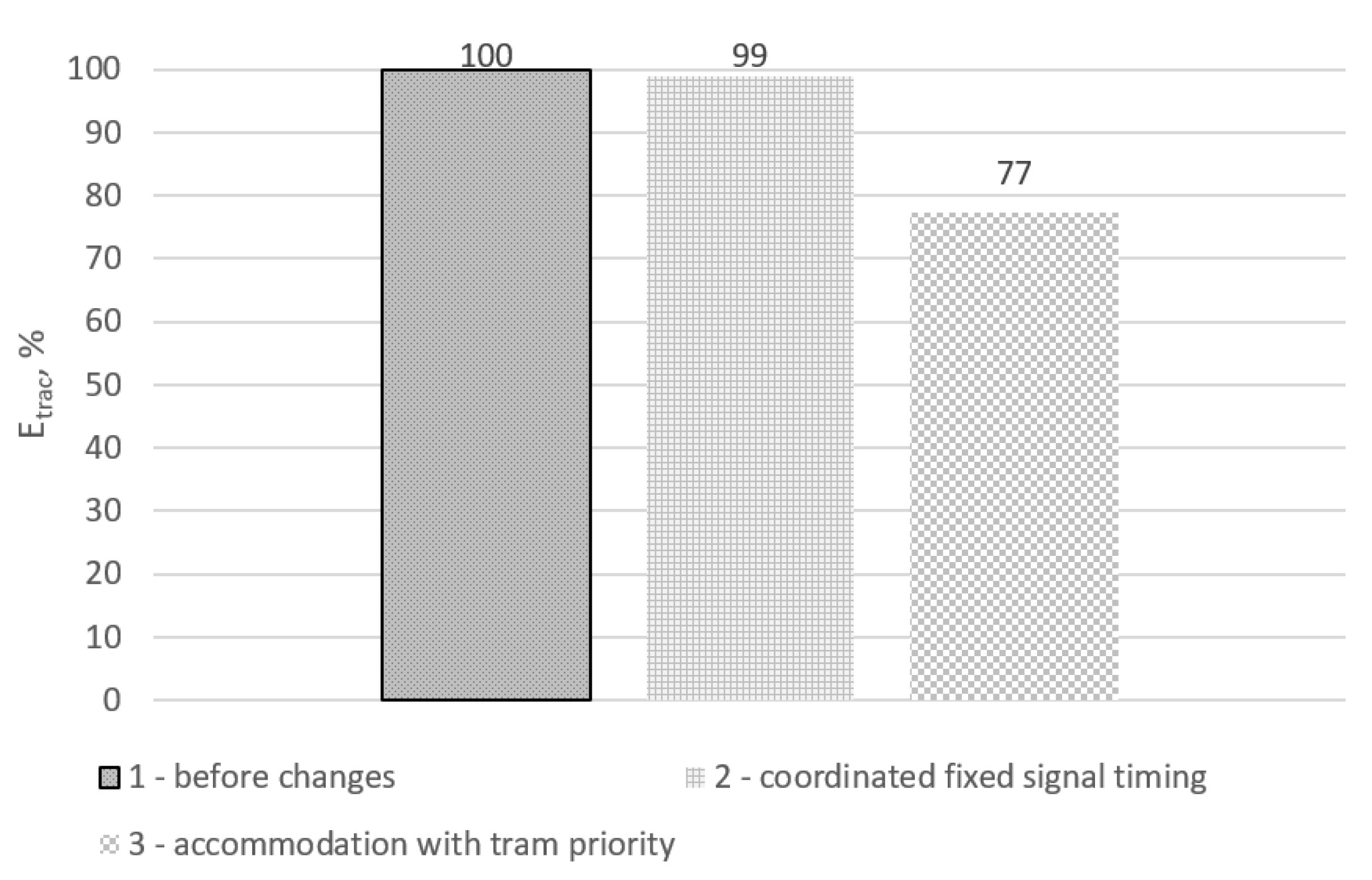
| Traffic Indicators | Variant 1 | Variant 2 | Variant 3 | |||
|---|---|---|---|---|---|---|
| Car | Tram | Car | Tram | Car | Tram | |
| Average speed [km/h] | 32.52 | 22.39 | 31.02 | 20.48 | 30.48 | 24.22 |
| Total travel delay [h] | 92.81 | 2.00 | 98.31 | 2.66 | 102.17 | 1.47 |
| Number of stops [-] | 15,041 | 81 | 14,138 | 164 | 14,010 | 27 |
| Type | Description | Value, [kWh] |
|---|---|---|
| E delivered | from the electrical supply network | 1015 |
| E recuperated | recuperated through braking | 122 |
| E consumed | used for traction (engine) | 788 |
| own needs during a stop | 143 | |
| own needs during a driving | 206 |
| Lane Number | Speed v, km/h | Acceleration a, [m/s 2 × 3.6] | Time t, [s] | Coordinate GeocX, [m] | Coordinate GeocY, [m] |
|---|---|---|---|---|---|
| 4 | 48.15 | 0.26 | 100.1 | −1020.2 | 853.3 |
| 4 | 48.32 | 0.46 | 100.2 | −1021.3 | 852.7 |
| 4 | 48.55 | 0.66 | 100.3 | −1022.5 | 852.0 |
| 4 | 48.86 | 0.86 | 100.4 | −1023.7 | 851.3 |
| … | … | … | … | … | … |
| Variant | Etrac, [kWh] | % |
|---|---|---|
| 1—before changes | 292 | 100 |
| 2—coordinated fixed-time control | 289 | 99 |
| 3—actuated control with tram priority | 226 | 77 |
Publisher’s Note: MDPI stays neutral with regard to jurisdictional claims in published maps and institutional affiliations. |
© 2021 by the authors. Licensee MDPI, Basel, Switzerland. This article is an open access article distributed under the terms and conditions of the Creative Commons Attribution (CC BY) license (https://creativecommons.org/licenses/by/4.0/).
Share and Cite
Czerepicki, A.; Krukowicz, T.; Górka, A.; Szustek, J. Traffic Light Priority for Trams in Warsaw as a Tool for Transport Policy and Reduction of Energy Consumption. Sustainability 2021, 13, 4180. https://doi.org/10.3390/su13084180
Czerepicki A, Krukowicz T, Górka A, Szustek J. Traffic Light Priority for Trams in Warsaw as a Tool for Transport Policy and Reduction of Energy Consumption. Sustainability. 2021; 13(8):4180. https://doi.org/10.3390/su13084180
Chicago/Turabian StyleCzerepicki, Andrzej, Tomasz Krukowicz, Anna Górka, and Jarosław Szustek. 2021. "Traffic Light Priority for Trams in Warsaw as a Tool for Transport Policy and Reduction of Energy Consumption" Sustainability 13, no. 8: 4180. https://doi.org/10.3390/su13084180
APA StyleCzerepicki, A., Krukowicz, T., Górka, A., & Szustek, J. (2021). Traffic Light Priority for Trams in Warsaw as a Tool for Transport Policy and Reduction of Energy Consumption. Sustainability, 13(8), 4180. https://doi.org/10.3390/su13084180






